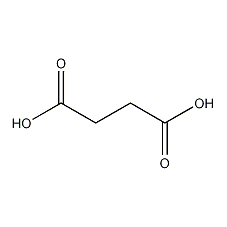
Structural formula
| Business number | 030N |
|---|---|
| Molecular formula | C4H6O4 |
| Molecular weight | 118.09 |
| label |
Succinic acid, Ethylene dicarboxylic acid, 1,2-ethanedicarboxylic acid, Ethane-1,2-dicarboxylic acid, Asuccin, Amber acid, Butanedioic acid, Pesticide intermediates; aliphatic carboxylic acids and their derivatives, acidic solvent |
Numbering system
CAS number:110-15-6
MDL number:MFCD00002789
EINECS number:203-740-4
RTECS number:WM4900000
BRN number:1754069
PubChem number:24899568
Physical property data
1. Properties: colorless crystals with a special acid ester smell.
2. Density (g/mL, 25/4℃): 1.572
3. Relative vapor density (g/mL, air=1): Undetermined
4. Melting point (ºC): 188
5. Boiling point (ºC, normal pressure): 235 (partially converted into acid anhydride)
6. Boiling point (ºC, 5.2kPa ): Undetermined
7. Refractive index at room temperature (n20): 1.405
8. Gas phase standard combustion heat (enthalpy) (kJ·mol-1): -1608.7
9. The gas phase standard claims heat (enthalpy) (kJ·mol-1): -822.6
10. The standard heat of combustion (enthalpy) of the crystal phase (kJ·mol-1): -1491.26
11. The standard claim heat (enthalpy) of the crystal phase (kJ· mol-1): -940.27
12. Crystal phase standard entropy (J·mol-1·K-1): 167.32
13. Crystal phase standard formation free energy (kJ·mol-1): -744.25
14. Critical temperature (ºC) :557.85
15. Critical pressure (KPa): 6.59
16. Log value of oil-water (octanol/water) partition coefficient: Undetermined
17 . Explosion upper limit (%, V/V): Undetermined
18. Explosion lower limit (%, V/V): Undetermined
19. Solubility: 1g of product dissolves in 13ml cold water, 1ml boiling water, 18.5ml ethanol, 6.3ml methanol, 36ml acetone, 20ml glycerin, 113ml ether, easily soluble in hot water, almost insoluble in benzene, carbon disulfide, carbon tetrachloride and petroleum ether.
20 Flash point (ºC): >110
Toxicological data
Minimum lethal dose (silica, subcutaneous) LC50: 2000mg/kg. Irritating.
Ecological data
This substance is harmful to the environment and can cause pollution to water bodies and the atmosphere. Organic acids can easily form acid rain during atmospheric chemistry and atmospheric physical changes. Therefore, when the pH value drops below 5, it will cause damage to animals and plants.. Determination of cerium, copper, lanthanum, scandium, ytterbium, yttrium and nitrite. Separation and determination of iron and aluminum. Gas chromatography standards. Buffer. Organic Synthesis. Manufacture of esters and succinates for paints, dyes, and perfumes. Take photos.
2.Used as alkali method standard reagent, buffer, and gas chromatography comparison sample. Used to test cerium, copper, lanthanum, scandium, ytterbium, yttrium, nitrite, and determine iron and lead.
3.Used as analytical reagents, such as preparing buffer solutions. Chromatographic analysis of standard materials. It is also used in organic synthesis of coatings, dyes, etc.
4.Succinic acid is used as an intermediate for fine chemicals and organic synthesis. Its main application areas include medicine, dyes, and organic pigments. , rubber vulcanization accelerators, alkyd resins, adhesives, lubricants, paper chemicals, plant growth accelerators, photographic chemicals, surfactants, ion exchange resins, pesticides, fungicides and cosmetics, etc.
5.Succinic acid is used in electroless nickel plating and brush chromium plating solutions.
6. Mainly used to prepare five-membered heterocyclic compounds such as succinic anhydride. Used medicinally as an antispasmodic, expectorant and diuretic. Used in analytical chemistry as a reagent to separate iron from other metals. Also used in the preparation of alkyd resins, spray paints and dyes.
7. Can be used in food in trace amounts. It can be used to prepare milky and fruity food flavors.

 微信扫一扫打赏
微信扫一扫打赏

